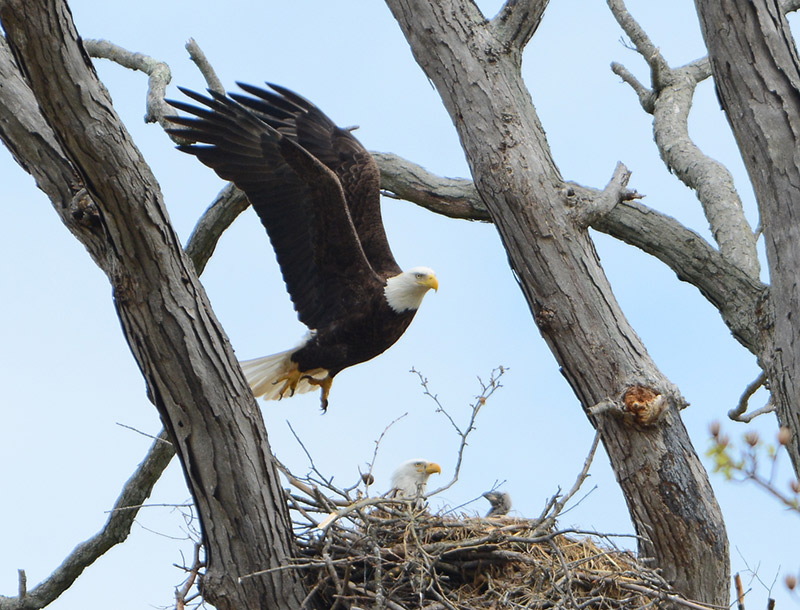[/av_textblock] [av_textblock size=” font_color=” color=” custom_class=”] FOR IMMEDIATE RELEASE
Feature Story
November 20, 2006
American Eagle Foundation announces new endowment fund to support eagle monitoring and protection nationally after bird loses Edanagered Species Act protection and related government funding – Americans invited to build $100 million “nest-egg” for U.S. freedom symbol.
Pigeon Forge, TN, November 20, 2006 – The Bald Eagle is set to lose its Endangered Species Act (ESA) protection and funding in early 2007. The American Eagle Foundation recently created a dedicated endowment that, when fully funded, will support monitoring and protection of America’s recovering eagle population for the long haul – even as the U.S. Fish & Wildlife Service tries to clarify its “post-delisting” strategy in order to address public feedback about how eagles will be tracked and safeguarded in the future. The Tennessee-based conservation group estimates it will take at least $100 million to watch over and care for the national bird for the remainder of the decade and beyond. It is inviting pro-American businesses, organizations and philanthropists to help build a financial “nest egg” that will ensure a progressive healthy status for eagles. “According to the Federal government, we now have over 7,000 nesting pairs of Bald Eagles in the lower 48 states today,” notes Al Cecere, President of the American Eagle Foundation, “If only 7,000 individuals or companies step forward and donate $15,000 each – or pledge $1,000 annually for 15 years — to symbolically adopt a single eagle nest, we’d have a national endowment of over $100 million to start with.”
Charity-savvy businesses and private citizens will find that the American Eagle Foundation (AEF) beats key non-profit integrity benchmarks. For every dollar of revenue and support received in 2005, the foundation spent less than 11 cents on fundraising and administration costs – a thrifty figure that would easily earn 4-star status for “fundraising efficiency” from watch-dog agencies. Since the late 1980s, the AEF has qualified to participate in the U.S. government’s Combined Federal Campaign (CFC), which requires charities to annually maintain high operating standards and prove diligent use of funds. The Foundation has consistently spent at least three-quarters of its annual revenues on eagle-related program services.
However, Cecere notes that the eagle still faces daunting post-delisting challenges – from loss of crucial nesting and foraging habitat to the threat of various contaminants, viruses and diseases. “The Bald Eagle will soon come off the ESA’s threatened species list, but that doesn’t mean it has fully recovered and won’t continue an up-hill fight for survival. In an era of government budget cutting, it will cost millions of dollars to monitor and protect eagle nests and adjacent ecosystems on private lands nationally for the remainder of this decade and beyond,” says Cecere, who has championed the eagle cause for more than 20 years. He points out that the Bald & Golden Eagle Protection Act of 1940 and Migratory Bird Treaty Act of 1918 will provide some protection for eagles after the delisting, but that neither law has strict provisions for buffering and securing nesting habitat, like the ESA presently does.
That’s why Cecere’s conservation group plans to earmark some of the funds it hopes to raise to promote and develop mutually beneficial “cooperative relationships” with private landowners and businesses. The AEF has already assembled a blue-ribbon advisory board of the nation’s top eagle experts to recommend best use of the endowment funds within federal eagle management guidelines. A qualified money management firm has been enlisted to wisely invest and grow those funds. But there’s another trend that works in his organization’s favor: a 2004 Cone Corporate Citizen Survey noted that 8 in 10 Americans say corporate support of causes wins their trust and loyalty. Says Cecere, “Recovering this special species is only half the battle – now we must fully secure its future livelihood. The majestic Bald Eagle is a precious national treasure that has symbolized our country’s democratic ideals for over 230 years. As a lasting legacy for America, we must keep it flying strong and free for generations to come.”
For more information about contributing to the American Eagle Fund, contact the American Eagle Foundation at PO Box 333, Pigeon Forge, TN 37868 or visit their WWW.EAGLES.ORG website.
###
Media Contact: Al Cecere, American Eagle Foundation Founder/President at 865-429-0157, 865-256-0372 or al@eagles.org.
About The AEF: The American Eagle Foundation (AEF) is a not-for-profit charitable organization established in 1985, dedicated to the care, recovery and protection of the bald eagle and its habitat. Headquartered at the Dollywood entertainment park in Pigeon Forge, Tennessee, the Federal and State licensed AEF conducts both environmental and eagle-focused education and recovery programs. It operates the world’s largest bald eagle exhibit and breeding facility. Since the mid 1990’s, the AEF has appeared with its trained, free-flying Bald Eagle ‘Challenger’ from coast-to-coast, including at the White House and various sporting events like the World Series, Olympics and Pro-Bowl All-Star Game. The conservation group has appeared with non-releasable eagles and other birds of prey on national TV shows including Good Morning America, Larry King Live, David Letterman, Fox & Friends, Dateline NBC, Jeff Corwin Experience, Jack Hanna’s Animal Adventures and Animal Planet. The AEF has also received a wide range of positive national press, from publications such as Audubon Magazine, USA Today, New York Times and Washington Post. Al Cecere is the AEF’s Founder & President.
[/av_textblock]

